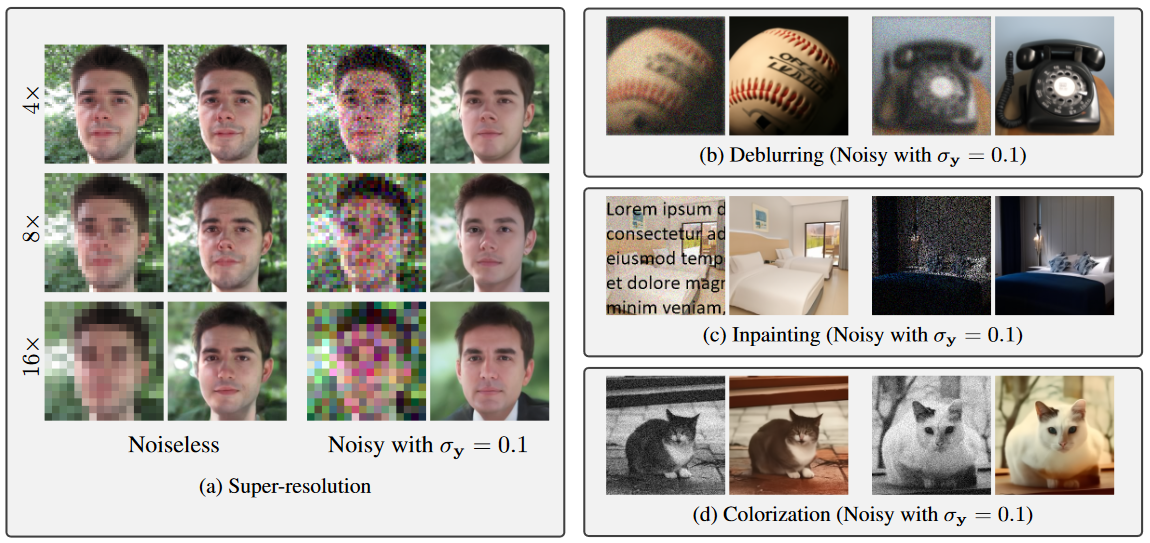arXiv | PDF | Project Website
Bahjat Kawar1, Michael Elad1, Stefano Ermon2, Jiaming Song2
1 Technion, 2Stanford University
DDRM use pre-trained DDPMs for solving general linear inverse problems. It does so efficiently and without problem-specific supervised training.
The code has been tested on PyTorch 1.8 and PyTorch 1.10. Please refer to environment.yml for a list of conda/mamba environments that can be used to run the code.
We use pretrained models from https://github.com/openai/guided-diffusion, https://github.com/pesser/pytorch_diffusion and https://github.com/ermongroup/SDEdit
We use 1,000 images from the ImageNet validation set for comparison with other methods. The list of images is taken from https://github.com/XingangPan/deep-generative-prior/
The models and datasets are placed in the exp/ folder as follows:
<exp> # a folder named by the argument `--exp` given to main.py
├── datasets # all dataset files
│ ├── celeba # all CelebA files
│ ├── imagenet # all ImageNet files
│ ├── ood # out of distribution ImageNet images
│ ├── ood_bedroom # out of distribution bedroom images
│ ├── ood_cat # out of distribution cat images
│ └── ood_celeba # out of distribution CelebA images
├── logs # contains checkpoints and samples produced during training
│ ├── celeba
│ │ └── celeba_hq.ckpt # the checkpoint file for CelebA-HQ
│ ├── diffusion_models_converted
│ │ └── ema_diffusion_lsun_<category>_model
│ │ └── model-x.ckpt # the checkpoint file saved at the x-th training iteration
│ ├── imagenet # ImageNet checkpoint files
│ │ ├── 256x256_classifier.pt
│ │ ├── 256x256_diffusion.pt
│ │ ├── 256x256_diffusion_uncond.pt
│ │ ├── 512x512_classifier.pt
│ │ └── 512x512_diffusion.pt
├── image_samples # contains generated samples
└── imagenet_val_1k.txt # list of the 1k images used in ImageNet-1K.We note that some models may not generate high-quality samples in unconditional image synthesis; this is especially the case for the pre-trained CelebA model.
The general command to sample from the model is as follows:
python main.py --ni --config {CONFIG}.yml --doc {DATASET} --timesteps {STEPS} --eta {ETA} --etaB {ETA_B} --deg {DEGRADATION} --sigma_0 {SIGMA_0} -i {IMAGE_FOLDER}
where the following are options
ETAis the eta hyperparameter in the paper. (default:0.85)ETA_Bis the eta_b hyperparameter in the paper. (default:1)STEPScontrols how many timesteps used in the process.DEGREDATIONis the type of degredation allowed. (One of:cs2,cs4,inp,inp_lolcat,inp_lorem,deno,deblur_uni,deblur_gauss,deblur_aniso,sr2,sr4,sr8,sr16,sr_bicubic4,sr_bicubic8,sr_bicubic16color)SIGMA_0is the noise observed in y.CONFIGis the name of the config file (seeconfigs/for a list), including hyperparameters such as batch size and network architectures.DATASETis the name of the dataset used, to determine where the checkpoint file is found.IMAGE_FOLDERis the name of the folder the resulting images will be placed in (default:images)
For example, for sampling noisy 4x super resolution from the ImageNet 256x256 unconditional model using 20 steps:
python main.py --ni --config imagenet_256.yml --doc imagenet --timesteps 20 --eta 0.85 --etaB 1 --deg sr4 --sigma_0 0.05
The generated images are place in the <exp>/image_samples/{IMAGE_FOLDER} folder, where orig_{id}.png, y0_{id}.png, {id}_-1.png refer to the original, degraded, restored images respectively.
The config files contain a setting controlling whether to test on samples from the trained dataset's distribution or not.
A list of images for demonstration purposes can be found here: https://github.com/jiamings/ddrm-exp-datasets. Place them under the <exp>/datasets folder, and these commands can be excecuted directly:
CelebA noisy 4x super-resolution:
python main.py --ni --config celeba_hq.yml --doc celeba --timesteps 20 --eta 0.85 --etaB 1 --deg sr4 --sigma_0 0.05 -i celeba_hq_sr4_sigma_0.05
General content images uniform deblurring:
python main.py --ni --config imagenet_256.yml --doc imagenet_ood --timesteps 20 --eta 0.85 --etaB 1 --deg deblur_uni --sigma_0 0.0 -i imagenet_sr4_sigma_0.0
Bedroom noisy 4x super-resolution:
python main.py --ni --config bedroom.yml --doc bedroom --timesteps 20 --eta 0.85 --etaB 1 --deg sr4 --sigma_0 0.05 -i bedroom_sr4_sigma_0.05
@inproceedings{kawar2022denoising,
title={Denoising Diffusion Restoration Models},
author={Bahjat Kawar and Michael Elad and Stefano Ermon and Jiaming Song},
booktitle={Advances in Neural Information Processing Systems},
year={2022}
}
This implementation is based on / inspired by:
- https://github.com/hojonathanho/diffusion (the DDPM TensorFlow repo),
- https://github.com/pesser/pytorch_diffusion (PyTorch helper that loads the DDPM model), and
- https://github.com/ermongroup/ddim (code structure)
